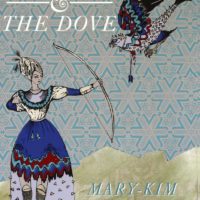My knowledge of the US military involvement in Korea from 1950–53 comes largely from watching M.A.S.H. reruns on channel 4 when I was a kid. I also know that according to the people for whom these terms make a difference, this military involvement was a police action and not a war. I’m sure there’s an importance to the distinction that I don’t understand, but I feel like to the people who suffered in the conflict, not so much.
The same is true for a common way the Korean War is referred to: the Forgotten War. It’s not the only result that comes up when you do an internet search, but it’s the most prominent, and again, the people who were there, as well as their descendants, almost certainly don’t think of it in those terms. This is the world where much of Mary-Kim Arnold’s newest collection, The Fish & The Dove, lives.
Before I tell you more, a quick reminder that in order to receive your early copy of The Fish & The Dove, read along with the Poetry Book Club, and participate in our exclusive chat with Mary-Kim Arnold, you’ll need to subscribe by February 15!
Arnold’s long, three-section poem “Forgotten War” begins with the line “No war is forgotten to those who lived through it.” Her speaker watches war documentaries online, asks “What am I searching for?” and later says “My mother was a child of this war. She blurs my vision.” Can you forget something you never really knew? Can you even claim it? Arnold writes: “Is it useful to ask / who is the enemy or where do I belong / useful to lay claim to someone else’s suffering / to keep watching / this endless march” and finishes the section with “Not useful / Not mine / Not now / Not while / all these bodies keep piling up / in my name.” And yet there’s still a need to gain knowledge, a yearning for greater understanding of this both intimate and distant part of her history. The poem ends with these lines:
You can stay up all night counting corpses
and still not know who you are.
You can open your mouth to speak
but still not know your own name.
There’s a lot of not-knowing in this collection, a lot of searching where answers at best only turn up more questions.
One of the most devastating moments in the book comes in the final poem, titled “In the Permanent Collection.” The first two sections dig into the idea that a museum collection is a form of invasion and colonization, a concept I had not encountered previously but which I suspect will strongly affect the way I consider them from now on. The second section, titled “Recent Acquisitions,” reads like a notice one might see at the entry to a special exhibit, concluding with the sentence, “Note the decorative effects marked by centuries of repeated invasion.” But it’s the “exhibits” themselves which really drive that point home. There are eight of them, each with an object description card placed in what looks to me like the middle of a page from the report from the Truth & Reconciliation Commission, Republic of Korea. The first of the exhibit cards reads:
Man’s Shoe, ca. 1951
Artist Unknown, Korean
Hemp; interlaced, knotted.
Object number: 2014.B5.1109
Gift of Anonymous Donor
This is placed against a background text that’s discussing massacres in the Geoje region from 1949. The text is hard to read, though—it’s faded and the font is small—and the shoe is completely abstracted here, existing only as a set of words. But it’s the “Artist Unknown” that really makes me uncomfortable—in a necessary way—because it makes me question the way I think about the limits of art, the borders between challenging one’s aesthetics and appropriating someone’s suffering for your own consumption. I spent a lot of time in those last ten pages and I think I won’t be the only reader who does.
I’m looking forward to talking more about The Fish & The Dove with our members and with Mary-Kim Arnold in our exclusive online chat. Subscribe to the Rumpus Poetry Book Club by February 15th to receive your early copy and make sure you don’t miss out on our author conversation!




